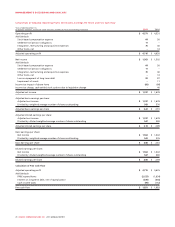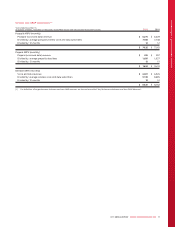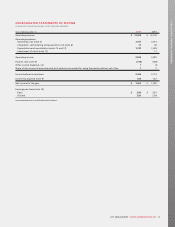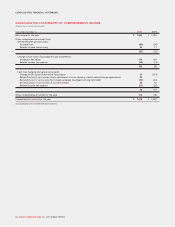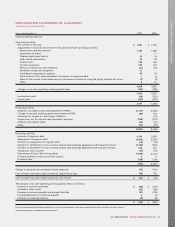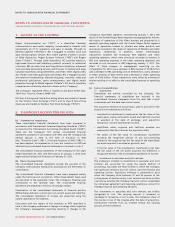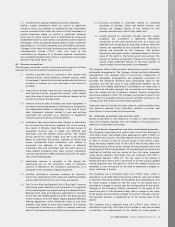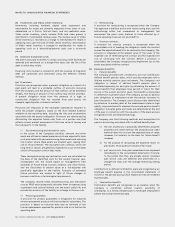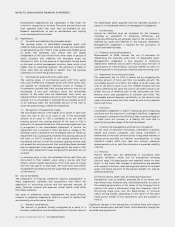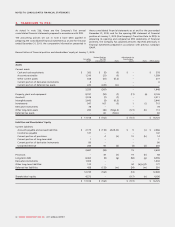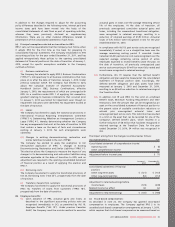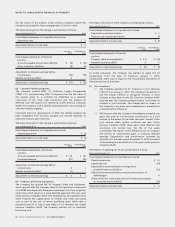Rogers 2011 Annual Report Download - page 90
Download and view the complete annual report
Please find page 90 of the 2011 Rogers annual report below. You can navigate through the pages in the report by either clicking on the pages listed below, or by using the keyword search tool below to find specific information within the annual report.
NOTES TO CONSOLIDATED FINANCIAL STATEMENTS
based on the fair value of the award at the date of grant. Changes in
the Company’s liability subsequent to the grant of the award and
prior to the settlement date, due to changes in the fair value of the
award, are recorded as a charge to income in the year incurred. The
payment amount is established as of the exercise date of the award.
The employee share accumulation plan allows employees to
voluntarily participate in a share purchase plan. Under the terms of
the plan, employees of the Company can contribute a specified
percentage of their regular earnings through payroll deductions and
the Company makes certain defined contribution matches, which are
recorded as compensation expense in the year made.
(g) Income taxes:
Income tax expense is comprised of current and deferred taxes.
Current tax and deferred tax are recognized in the consolidated
statements of income except to the extent that they relate to a
business combination, or items recognized directly in equity or in OCI.
Current tax is the expected tax payable or receivable based on the
taxable income or loss for the year, using tax rates enacted or
substantively enacted at the reporting date, and any adjustment to
tax payable in respect of previous years.
Deferred tax assets and liabilities are recognized for the future
income tax consequences attributable to differences between the
financial statement carrying amounts of existing assets and liabilities
and their respective tax bases. Deferred tax assets and liabilities are
measured using enacted or substantively enacted tax rates expected
to apply to taxable income in the years in which those temporary
differences are expected to be recovered or settled. Deferred tax
assets and liabilities are offset if there is a legally enforceable right to
offset current tax liabilities and assets and they relate to income taxes
levied by the same authority on the same taxable entity, or on
different tax entities where these entities intend to settle current tax
liabilities and assets on a net basis or their tax assets and liabilities will
be realized simultaneously.
(h) Foreign currency translation:
Monetary assets and liabilities denominated in a foreign currency are
translated into Canadian dollars at the exchange rate in effect at the
consolidated statements of financial position dates and non-monetary
assets and liabilities and related depreciation and amortization
expenses are translated at the historical exchange rates. Revenue and
expenses, other than depreciation and amortization, are translated
into Canadian dollars at the average rate for the month in which the
transaction was recorded. Exchange gains or losses on translating
long-term debt are recognized in the consolidated statements of
income and consolidated statements of comprehensive income, as
applicable. Foreign exchange gains or losses are primarily related to
the translation of long-term debt.
(i) Financial and derivative instruments:
(i) Recognition:
The Company initially recognizes loans and receivables, debt
securities and subordinated liabilities on the date they originate.
All other financial assets and financial liabilities are initially
recognized on the trade date at which the Company becomes a
party to the contractual provision of the instrument. Financial
assets and financial liabilities are offset and the net amount
presented in the consolidated statements of financial position
when the Company has a legal right to offset the amounts and
intends either to settle on a net basis or to realize the asset and
liability simultaneously.
(ii) Classification and measurement:
(a) Non-derivative financial instruments:
Financial instruments are, for measurement purposes,
grouped into classes. The classification depends on the
purpose and is determined at initial recognition. All of the
Company’s non-derivative financial assets are classified as
available-for-sale or loans and receivables.
Available-for-sale financial assets are comprised of the
Company’s publicly traded and private investments. These
investments are carried at fair value plus transaction costs
directly attributable to the acquisition of the financial
asset, on the consolidated statements of financial position,
with subsequent changes in fair value, other than
impairment losses, recorded in the available-for-sale
financial assets reserve, a component of equity, through
OCI, until such time as the investments are disposed of, at
which time the cumulative fair value change in OCI related
to the disposed investments is transferred to income.
Upon initial recognition, all of the Company’s loans and
receivables, comprised of cash and cash equivalents and
accounts receivable are measured at fair value plus
transaction costs directly attributable to the acquisition of
the financial asset and subsequently carried at amortized
cost using the effective interest method, with changes
recorded through net income.
All of the Company’s non-derivative financial liabilities are
classified as other financial liabilities and are initially
measured at fair value plus transaction costs that are
directly attributable to the issue of the financial liability.
Subsequent to the initial recognition and measurement,
these non-derivative financial liabilities are measured at
amortized cost using the effective interest method. Such
liabilities include bank advances arising from outstanding
cheques, accounts payable and accrued liabilities,
provisions, and long-term debt.
(b) Derivative financial instruments:
The Company uses derivative financial instruments to
manage risks from fluctuations in exchange rates and
interest rates, with respect to debt (“Debt Derivatives”) and
to manage risks from fluctuations in exchange rates on
certain forecast expenditures (“Expenditure Derivatives”
and, together with Debt Derivatives, “Derivatives”). From
time to time, these instruments include cross-currency
interest rate exchange agreements, interest rate exchange
agreements, foreign exchange forward contracts and
foreign exchange option agreements. All such instruments
are only used for risk management purposes. The Company
does not use derivative instruments for speculative
purposes.
All derivatives, including embedded derivatives that must
be separately accounted for, are measured at fair value,
with changes in fair value recorded in the consolidated
statements of income unless they are effective cash flow
hedging instruments and designated as such for accounting
purposes. The Company assesses whether an embedded
derivative is required to be separated from the host
contract and accounted for as a derivative when the
Company first becomes a party to the contract. The changes
in fair value of cash flow hedging derivatives are recorded
in the hedging reserve, a component of equity, to the
extent effective, until the variability of cash flows relating
to the hedged asset or liability is recognized in income. Any
hedge ineffectiveness is recognized in income immediately.
On initial designation of a derivative instrument as a
hedging instrument, the Company formally documents the
relationship between the hedging instrument and hedged
item, including the risk management objectives and
86 ROGERS COMMUNICATIONS INC. 2011 ANNUAL REPORT


